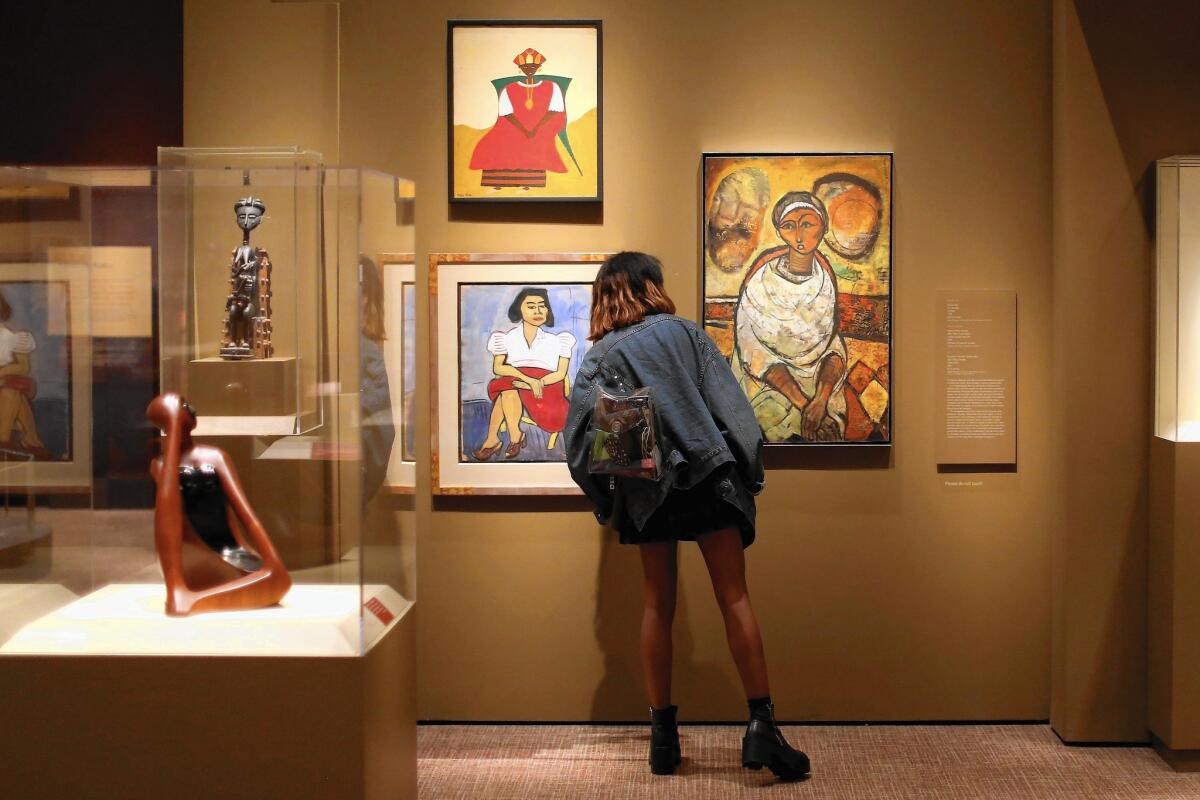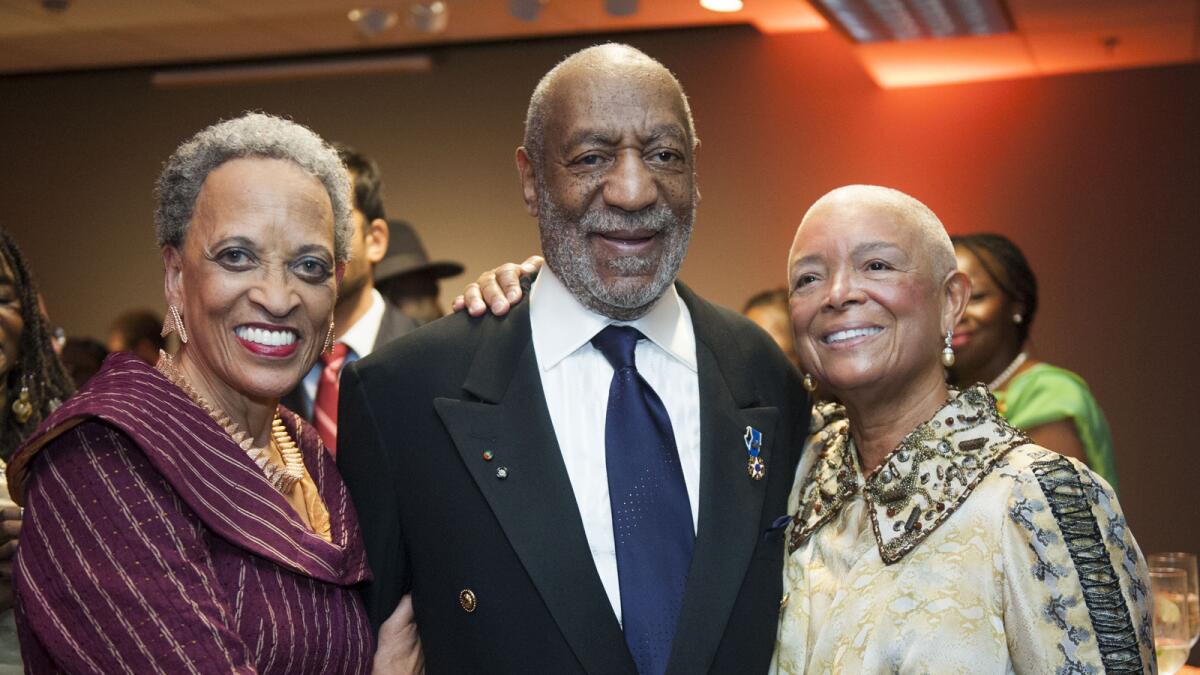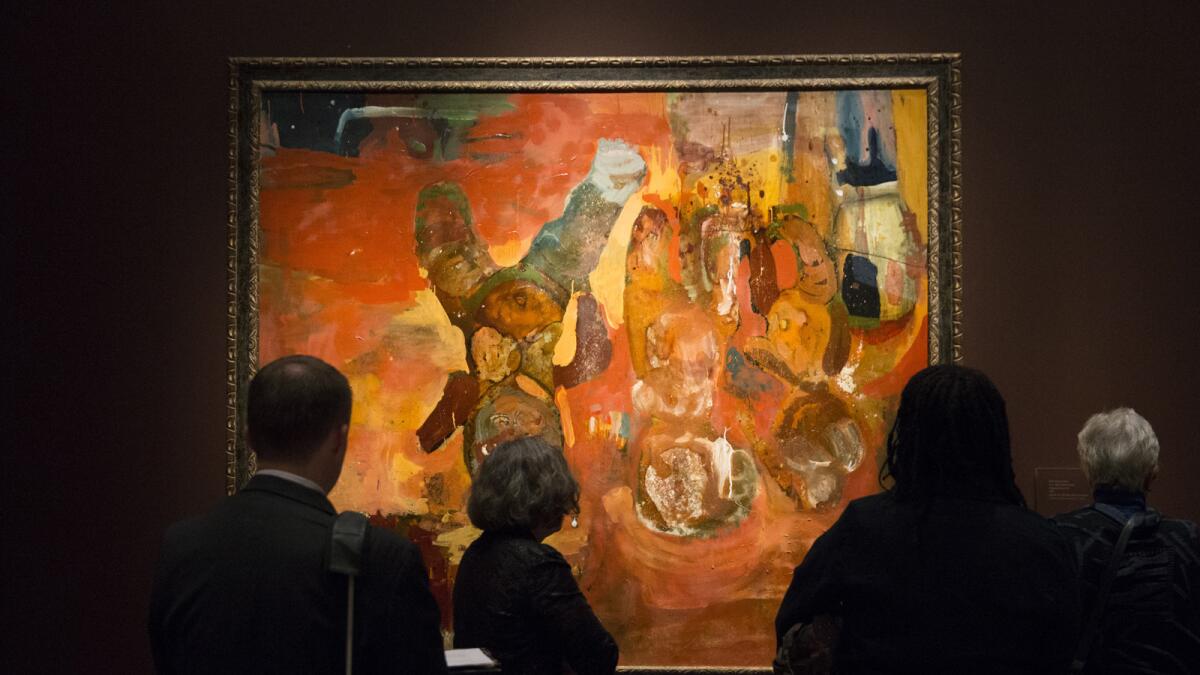Critic’s Notebook: Bill Cosby art collection: How the National Museum of African Art shot itself in the foot

Reporting from WASHINGTON, D.C. — Watching an art museum shoot itself in the foot is painful. Watching it then deny responsibility for the mess it has made is exasperating.
A year ago this week, the Smithsonian’s National Museum of African Art took aim and squeezed the trigger, blowing off a few toes and a couple of metatarsals. Then, executing a hasty if bloody pirouette, it feigned innocence for the awful mess.
It still is. And it’s way past time to stop dissembling — and to start taking positive action.
SIGN UP for the free Essential Arts & Culture newsletter >>
An exhibition anchored by the private art collection assembled over four decades by comedian Bill Cosby and his wife, Camille, had just launched with a star-studded gala in celebration of the museum’s 50th anniversary.
During a routine National Public Radio interview promoting the show, the then-77-year-old entertainer was asked about a video clip that had recently gone viral online. It contains stinging allegations of sexual assaults. Cosby answered the reporter with silence.

Johnnetta Betsch Cole, left, National Museum of African Art director, with Bill and Camille Cosby at a 2014 museum gala.
The ensuing dead air opened a yawning audio chasm. Within days of the broadcast — and the museum opening — the media scrutiny was intense.
Cosby has not been charged in any criminal case regarding any accusations and through attorneys has repeatedly denied that any of the allegations are true. Although claims surfaced in the press as long as 15 years ago, mostly they stayed below the public radar.
Social media changed that. This time the rape story took off, quickly reaching gale force. Claims of assault, sexual battery and other misconduct have gotten more forceful ever since. Accusers number more than 50.
Cosby’s intended show-business comeback — including a new biography, planned television shows and the prestige of an art exhibition at a national museum — went up in flames. As it burned, the Smithsonian got badly scorched.
The museum had only itself to blame. The Cosby collection show is a vanity exhibition. Surely the museum would deny it, but surfing celebrity taste is the exhibition’s bland motif. Consequently, as Cosby goes, so goes the national museum.
The exhibition, “Conversations: African and African American Artworks in Dialogue,” pairs African art from the NMAA’s permanent collection with paintings, sculptures and drawings owned by the couple. Their artistic preferences, philosophy of collecting and views on what is aesthetically important guide the insipid show. Why a museum public is supposed to take an interest in a private collector’s shopping list is anybody’s guess.
Idealized, sanitized and sentimental, the Cosbys’ artistic interests are not even especially distinguished. A recent visit to “Conversations” confirmed what other reviewers have said: The selection — 62 works from about 300 in their collection — is studded with some wonderful individual examples, from Joshua Johnston, Robert S. Duncanson and Henry Ossawa Tanner in the 19th century to Jacob Lawrence, Alma Thomas and Charles White in the 20th.
There are more. But in sum, it’s mediocre, including minor examples by major artists.
And at moments, the show is even like biting down on aluminum foil. The nadir is a rear wall adorned with a few nice quilts, which made me wince.

Members of the media tour the Bill and Camille Cosby collection at the Smithsonian’s National Museum of African Art in Washington.
The greeting-card legend printed in big letters across the wall quotes the collector: “Quilts tell a story of life, of memory, of family relationships — Bill Cosby.”
Faith Ringgold is a talented artist, but given the ugly turn the Cosby story took, her joyful 1988 story-quilt is now discordant. Made as a 50th-birthday gift from Camille to Bill, it features nearly four dozen cheerful family portraits and genre scenes from different stages of life. The flower patterns on the pieced fabrics are symbolic of tribute while they are edged in crimson paisley — an ancient design signifying fertility.
But any quilted ethos of sweet family fecundity has long since been ruined. Just a day before I saw the show, for example, The Times reported that a Los Angeles County Superior Court judge ruled a lawsuit accusing the comedian of molesting a 15-year-old at the Playboy Mansion in 1974 could proceed.
How embarrassing for the museum — a mortification repeated time and again during the past year, as story after story of Cosby’s accusers rolled through the press.
Yet I can’t muster much sympathy for the place. Not just because the museum foolishly decided to present a vanity show, which is bad enough. But because, when the scandal blew up, the NMAA began to dodge, weave and dissemble.
“The National Museum of African Art in no way condones Mr. Cosby’s behavior,” says a prim disclaimer on a sign posted at the show’s entry, in case we had any doubt. “We continue to present ‘Conversations: African and African American Artworks in Dialogue’ because it is fundamentally about the artworks and the artists who created them, not Mr. Cosby.”
As the great and powerful Oz sputtered in desperation when his charade was exposed: Pay no attention to the man behind the curtain — or perhaps behind the quilt. Nonsense. Fundamentally, the Smithsonian show is about a celebrity and his art-collecting tastes. Even Toto knows that.
The posted disclaimer further pleads: “The exhibition brings public attention to artists whose art has not been seen, art that tells powerful and poignant stories about African American experiences.” Apparently we’re to be grateful that Cosby has rescued these artists from obscurity.
Really? Most if not all of them are represented in another museum less than a mile away — in the NMAA’s sister institution, the Smithsonian American Art Museum. Its collection includes about three dozen Tanner oil paintings, 26 Thomas acrylics, 22 Duncanson oils, 10 works by Lawrence, four White graphics and many, many more.
There are four Johnston portraits. The fine Cosby example, a standout society portrait, “Lady on a Red Sofa” (circa 1825), is paired with a carved female figure by an unidentified artist of Africa’s Baoulé people, the high social rank of both women signified by the luxury of beaded necklaces.
But Cosby’s Johnston could easily be swapped out for the other museum’s “Mrs. Barbara Baker Murphy” (circa 1801), a portrait of a prominent Baltimore sea captain’s wife adorned with a necklace of white beads. There’s nothing specific about the show’s inclusion of “Lady on a Red Sofa” except that a celebrity owns it.
These artists — and indeed all of the artists in the Cosby collection — have been seen. They should be seen more. But a serious analysis of the varied “conversations” between African American and African art would not limit itself to one narrow collection. This show is about Cosby.
Like many people, I had followed the institutional scandal closely in the press, stunned first by reports that Camille Cosby sits on the museum’s advisory board, then that the show features a large painting by Erika Ranee Cosby, the couple’s daughter, and finally that the family underwrote their exhibition with a tax-deductible donation of $716,000. That the NMAA’s director, Johnnetta B. Cole, an old Cosby family friend, either did not appreciate or chose not to recognize the appearance of pay-to-play at her institution is sobering.
Cole essentially remained silent on the issue for more than eight months. When she finally went public in an August opinion piece for a website, she merely reiterated the exhibition’s dodgy posted disclaimer.
Presenting an ethically challenged vanity show and then trying to fix its mistakes with a deceptive sign, as the Smithsonian has done, is infuriating. Maybe it’s a Washington thing — a wink-wink, nod-nod, institutional shuffle that implies “we can’t tell the truth, so here’s some political spin.”
The law and the court of public opinion will deal with the rape charges. Serially cheating on his spouse makes Cosby just another American, while doing it as he lectures on moral probity in cringe-worthy interviews and books like “Love and Marriage” and “Come On, People” makes him just another hypocrite. But a national museum treating its audience like oblivious children is insulting.
The Smithsonian’s new secretary, David Skorton, has defended the show against reasonable calls for its closure. Citing censorship fears, he told the Washington Post in September, “I believe taking down an exhibition will tarnish our reputation among museum professionals and others.”
So does keeping it up while fudging its rationale. The NMAA, having decided a year ago not to shutter what is billed as “a major part of the museum’s 50th anniversary,” should craft a firm, formal policy against vanity shows — sooner rather than later.
Smart museums, such as the Museum of Modern Art in New York, essentially ban them. Hitching a public institution’s reputation, which is hard-won over time, to one passing private collector is never a good idea — artistically or practically.
Cosby-wise, this crass display has three more scary months to go. While it sits on its hands, the Smithsonian might want to cross its fingers too.
ALSO:
‘Rain Room,’ technology’s hot-ticket riff on Mother Nature
‘Jim Shaw: The End Is Here’ taps public’s id in a weird, humorous way
Steve Martin-curated Lawren Harris exhibition shines light on landscapes physical and metaphorical
More to Read
The biggest entertainment stories
Get our big stories about Hollywood, film, television, music, arts, culture and more right in your inbox as soon as they publish.
You may occasionally receive promotional content from the Los Angeles Times.











